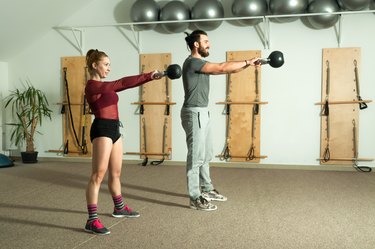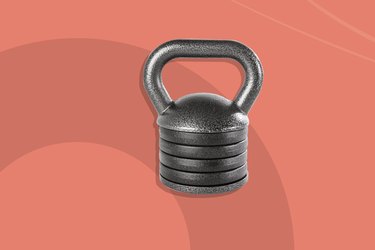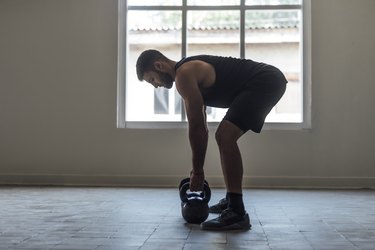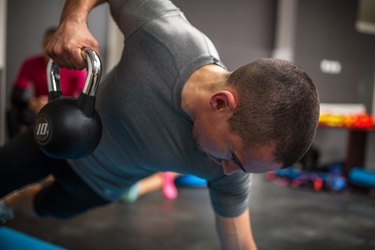

Kettlebell swings are among the most powerful exercises you can do to strengthen your entire body. A hip-dominant move, the kettlebell swing targets your glutes and hamstrings, but also gives your core some attention.
Although the swing seems like a simple, full-body kettlebell exercise, it takes practice to refine your technique and engage the right muscles. Doing kettlebell swings with proper form not only makes them more effective but also helps prevent injury.
Video of the Day
Video of the Day
"The swing is ballistic, meaning it's supposed to happen very quickly. The swing is an exercise that requires you to be mentally present, especially as you are learning it because there are a lot of little details that go into it, such as breath, tension, timing and alignment. So, to do something fast that is technical can be physically and neurologically challenging," says Colleen Conlon, CPT, a certified kettlebell coach and author of Kettlebell Catalyst: The Exercise Guide for Women to Build Strength, Lean Muscle, and Self-Confidence to Overcome Limiting Beliefs.
If you're wondering what you can do to improve your kettlebell swing game, here are some common mistakes and what you can do to fix them.
If You: Don't Feel It in Your Glutes and Hamstrings
You Might: Need to Re-Evaluate Your Setup
One of the most common mistakes people make with the kettlebell swing is setting up the exercise with a squat versus a hip hinge. As a result, they use their lower back and quads to drive the movement, which not only makes the exercise ineffective but can also cause lower-back injury, according to Mike Silverman, CPT, a senior kettlebell instructor with Living.Fit.
"The swing is a hip-dominant exercise. The power comes from the hips after the initial hike back," he says. "If you are loading more into your quadriceps by squatting versus your hamstrings by hinging, you will not have the help from your hips to send the bell upward."
Fix It
Silverman recommends practicing the hip hinge with just your body before adding weights. Stand with your feet shoulder-width apart and place your fingers on your hips as you push your pelvis back a foot; you should feel your hamstrings engage.
"Before you begin to swing you want to feel confident holding a plank and deadlift," Conlon says. "The swing is a fast deadlift where the bell finishes out in front of you at chest height versus the front of the hips. From there, drills like hike backs and dead-stop swings are great to perform to practice things like breath, timing and alignment."
Before adding a hike, Silverman suggests doing a short swing, where you hold the kettlebell by your hips (think: your belt buckle). Then, initiate a short hinge by pushing your butt back, snapping your hips back up to stand.
When you're ready to do a traditional kettlebell swing, follow this set-up from Conlon: Stand approximately a foot and a half away from the kettlebell on the floor and stand with your feet hip-width distance. The bell should face you with the horns horizontal to your body. Looking down at the bell in front of you, maintain a neutral neck and keep your shoulders higher than your hips and your hips higher than your knees.
Your knees should be in line with — if not slightly behind the balls of your feet — so that you can feel your hamstrings loading. From there, reach for the horn of the bell and tip it on a slight diagonal.
"You may need to adjust your bell either slightly forward or backward so that your arms are straight and you can engage your lats (back muscles)," Conlon says. Pull your shoulders down and back and imagine breaking the horn apart to activate your lats. Then, hike the bell between your legs. This setup helps ensure that the power comes from your hips.
Need help activating your glutes? Silverman recommends warming up with some banded monster walks and glute bridges.
If You: Use Your Arms to Lift the Kettlebell
You Might: Need to Adjust Your Grip and Use Your Hips
You may find yourself gripping the kettlebelll too hard when swinging, making your arms and shoulders work harder to lift the weight, Silverman says. But the swing isn't a front raise. You want your arms to guide (not lift) the bell.
"Your grip should be tighter before the float and in the back swing. Other than that, the momentum is going to do the rest of the work. At the top of the swing, try to open up your hands and then grab it again before driving it down," he says.
Fix It
One drill Silverman recommends to correct holding the kettlebell too tight is to do a catch-and-release drill in the bent-over row position: Hold onto the kettlebell as you row it up past your rib cage, then release it as you drop it down and catch it with your opposite hand.
If you're using your arms to lift the kettlebell, that's also a sign that you're not using a weight that's too light, Conlon says. But the fix isn't as cut and dry as choosing a heavier kettlebell.
Conlon recommends doing a towel drill. Thread a hand towel through the horn and tip the bell on a slight diagonal on the floor before you start your reps. At the top of the swing, the horn and the butt of the kettlebell should be an extension of your arm, she explains.
"The goal for the person trying to not lift the bell [with their arms] is to use their hips to send the bell up," she says. "Once the bell begins to appear it's an extension of the arms, that's how they know that they are no longer lifting the bell with their arms but using their hips."
If You: Can't Hold a Plank at the Top of the Swing
You Might: Need to Activate Your Core
At the top of a kettlebell swing, your body should resemble a standing plank, with your shoulders stacked over your hips, your arms at chest height and your knees and elbows straight, Conlon says. Your lats, core and glutes should contract.
If you're not able to hold this standing plank position and find that you're hyperextending (overarching) your back or are being pulled too far forward by the weight, you may need to strengthen your core.
"The combination of weak or underactivated abs, obliques and glutes tends to really cause arching. Bracing a set of strong abs and tightening up your butt really stabilizes the T-spine and pelvis," Silverman says.
In some cases, you may be pushing or thrusting your hips too far forward, which can also cause an over-arching back. In that case, stand a bit taller and watch your form in the mirror to make sure your hips stay in line as you return to standing.
Fix It
If you're leaning forward, focus on connecting your feet to the ground, Conlon says. "You want to feel yourself trying to rip the ground apart the whole time — the same way you would if you were to resist someone trying to push you over. "
If you're leaning back, get into a plank position on the ground. This will help you bring some awareness to your core, then find that same core contraction to your swing, she says.
Planks are also a great way to strengthen your core, including your abs and obliques. As you're holding a plank, think about squeezing your glutes and bracing your abs throughout the exercise. If you're not able to hold a forearm or high plank, regress to a plank on your knees.
"Side planks are also fantastic for your obliques and abductors. I'm also a big fan of hollow holds. For any of these, I'd suggest 30 seconds on, 10 seconds off, for four rounds. Much more than 2 minutes of planking tends to be diminishing returns," Silverman says.
Similarly, if your shoulders are rounding at the top of the swing, that means your lats aren't engaged and your chest muscles are tight. Focus on keeping your shoulder blades down and back throughout the exercise. Doing row variations also helps get your shoulders and upper back into a more neutral position.
"Since most of my clients work desk jobs, I tend to program a row of some sort for them, so this will generally solve itself. TRX high rows, moto rows with a resistance band tied to a rack or railing and bent-over kettlebell rows are all good choices," Silverman says.
If You: Aren't Allowing the Kettlebell to Float the Top of the Swing
You Might: Need to Work on the Timing of Your Hip Hinge
Your kettlebell should float at the top of the swing with the horn and the butt of the bell as an extension of your arms. Allowing the kettlebell to float at the top keeps your lower back safe and makes the exercise more efficient, Conlon says.
"You don't want to hinge your hips on the way down until the bell hits bellybutton height. The closer the bell gets to you the shorter the lever length. This will help you load up your hips more efficiently as it helps provide more power for the next rep," she says. "If you hinge too early, you increase the lever length and put excess strain on your lower back."
Fix It
Conlon recommends practicing the swing with just your body-weight. The goal is to allow your hands to drop to bellybutton height, then hinge at your hips and then bend at your knees, she says.
"Many people struggle with this, so see you can be aware enough to do it without a bell before adding it in."
If You: Hyperventilate or Hold Your Breath
You Might: Need to Improve Your Breathing Technique
If you're not corresponding your breath with the swing properly, then it can make the exercise feel extra hard.
Essentially, "you want to make sure you are breathing deep into your diaphragm versus your chest as you prepare for your set of swings," Conlon says.
Fix It
Your breathing pattern should be: Inhale, hike, exhale, stand, repeat, Conlon says.
"On the exhale, you want a short exhale that sounds like 'tst.' It should sound as short and powerful as a dart hitting a target. This breathing will help you create more pressure within the thoracic cavity, which can help prevent you from leaning back, protect your low back and keep you moving quickly."



